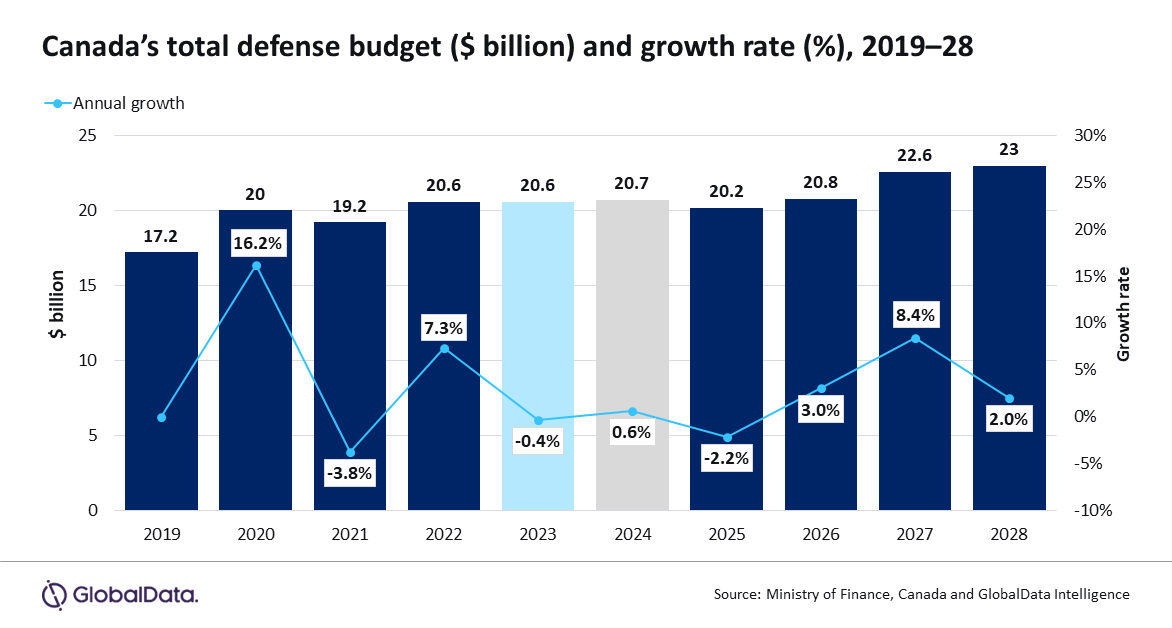Modernization efforts to spur Canada’s defense expenditure to $23 billion in 2028, observes GlobalData
Canada’s defense strategy is mainly designed to safeguard its national interests and support its allies in their objectives towards global security. The country is expected to increase its defense budget to $23 billion in 2028 with a modest compound annual growth rate (CAGR) of 2.7% over the period 2024–28 to modernize its armed forces through platform upgrades and the procurement of key military platforms, according to GlobalData, a leading data and analytics company.
GlobalData’s latest report, “Canada Defense Market Size and Trends, Budget Allocation, Regulations, Key Acquisitions, Competitive Landscape and Forecast, 2023 –28,” reveals that Canada’s defense budget increased from $17.2 billion in 2019 to $20.6 billion in 2023, reflecting a CAGR of 4.5% over 2019–23. However, despite this growth, the defense budget as a percentage of gross domestic product (GDP) fails to meet the North Atlantic Treaty Organization (NATO) standards of 2% of GDP.

Rouble, Aerospace & Defense Analyst at GlobalData, comments: “The Canadian Air Force (CAF) still relies on aging platforms that may not be fully equipped to meet the demands of modern warfare. However, the acquisition of 88 new F-35A fighter jets and frigates is a step in the right direction. The F-35A fighter jets will provide the CAF with several advantages over its current fleet of CF-18 Hornets, including superior air-to-air and air-to-ground combat capabilities, enhanced interoperability, and deterrence.
“The recent decision by Canada to procure Boeing’s P-8A Poseidon under the Canadian Multi-Mission Aircraft (CMMA) project further underscores the country’s commitment to modernize and adapt to evolving security challenges.”
In line with its defense modernization strategy, Canada is revitalizing its naval capabilities as well. According to GlobalData estimates, Canada’s expenditure on procuring various categories of naval vessels will reach $23.4 billion from 2023–28, making it the largest defense sector. At the forefront is the Canadian Surface Combatant (CSC) Project, the largest procurement initiative in Canadian military history. This project aims to replace the aging Halifax-class frigates with a fleet of up to 15 warships equipped with advanced sensors, weapons, and combat systems. However, the CSC Project is facing significant challenges, including cost overruns and delays that have pushed the delivery of the first ship by several years.
Rouble concludes: “The Canadian government needs to strike a delicate balance between defense spending and other social priorities. Budgetary limitations have hindered the acquisition of new platforms, leaving both the air force and navy with outdated equipment, diminishing their effectiveness in safeguarding Canada’s airspace and waters.
“The procurement programs will certainly assist in mitigating some of these concerns; however, a more robust approach is required, involving increased funding, expedited modernization efforts, and the implementation of adaptive strategies to effectively tackle these challenges.”
Source: GlobalData









Be the first to comment on "Modernization efforts to spur Canada’s defense expenditure"